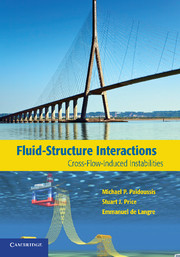Book contents
- Frontmatter
- Contents
- Preface
- 1 Introduction
- 2 Prisms in Cross-Flow – Galloping
- 3 Vortex-Induced Vibrations
- 4 Wake-Induced Instabilities of Pairs and Small Groups of Cylinders
- 5 Fluidelastic Instabilities in Cylinder Arrays
- 6 Ovalling Instabilities of Shells in Cross-Flow
- 7 Rain-and-Wind-Induced Vibrations
- Epilogue
- Appendix A The Multiple Scales Method
- Appendix B Measurement of Modal Damping for the Shells Used in Ovalling Experiments
- References
- Index
1 - Introduction
Published online by Cambridge University Press: 04 February 2011
- Frontmatter
- Contents
- Preface
- 1 Introduction
- 2 Prisms in Cross-Flow – Galloping
- 3 Vortex-Induced Vibrations
- 4 Wake-Induced Instabilities of Pairs and Small Groups of Cylinders
- 5 Fluidelastic Instabilities in Cylinder Arrays
- 6 Ovalling Instabilities of Shells in Cross-Flow
- 7 Rain-and-Wind-Induced Vibrations
- Epilogue
- Appendix A The Multiple Scales Method
- Appendix B Measurement of Modal Damping for the Shells Used in Ovalling Experiments
- References
- Index
Summary
General Overview
Cross-flow-induced vibration of bluff bodies, i.e. bodies whose aspect is not small compared with the streamwise dimension, are ubiquitous, in nature as well as in man-made constructions. The wind-induced fluttering of leaves and tree branches and the waving motions in wheat fields are examples of the former. The Aeolian harp, going back perhaps 3000 years, is an example of the earliest realization and/or exploitation of the existence of these vibrations made by man.
Perhaps the first documented and surviving realization of the existence of vortex shedding as such goes back to two Renaissance paintings in Bologna and a sketch by Leonardo da Vinci, thus, to the 14th and 15th centuries. The modern study of vortex shedding began in the late 19th century, with Strouhal (1878), Bénard (1908) and von Kármán (1912). Studies on vortex-induced vibrations followed soon after; lock-in, or shedding frequency synchronization, was first documented by Bishop & Hassan (1964).
With such a venerable and long pedigree, it is not surprising that the topic of cross-flow-induced vibrations and instabilities of bluff bodies, notably cylinders or groups of cylinders, is truly vast. To make any headway in this topic, one must first understand the fluid mechanics of the flow around bluff bodies, while stationary or in motion, and the forces generated thereon.
- Type
- Chapter
- Information
- Fluid-Structure InteractionsCross-Flow-Induced Instabilities, pp. 1 - 14Publisher: Cambridge University PressPrint publication year: 2010



